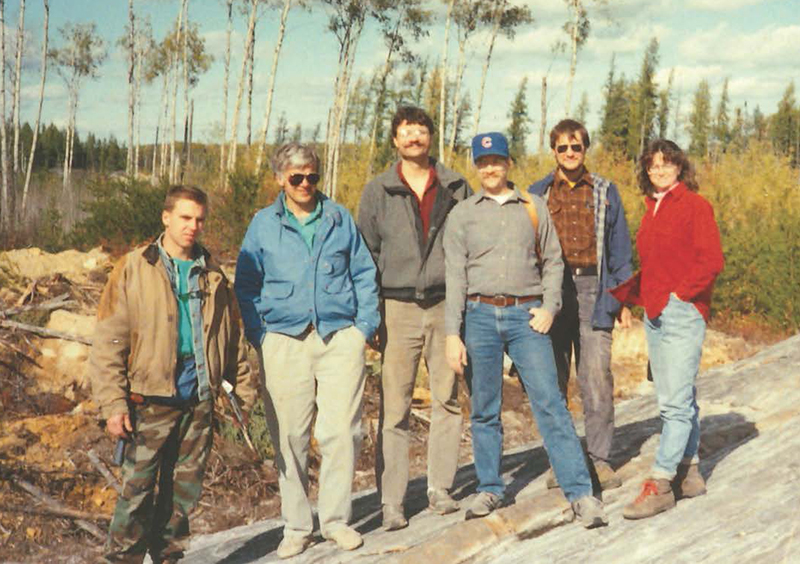Remembering Nik Christensen
08-18-2022
It is with great sadness that we report the passing of our friend and colleague Nikolas I. Christensen. Nik died in his home in Anacortes, Washington State of natural causes on May 19, 2022. He was 85 years old.
Nik will be remembered as a gifted Earth scientist who made fundamental contributions to geology and geophysics, particularly the physical properties of the oceanic and continental crust and mantle lithosphere. He stood out for his exceptional skills in the laboratory and was the world's foremost authority on elastic properties of crustal and upper mantle lithologies. His measurements of seismic velocities on the full range of commonly occurring rock types have provided the basis for countless interpretations of active and passive seismic studies aimed at understanding lithospheric structure and evolution.
A Wisconsin native, Nik began his career at the University of Wisconsin-Madison earning the B.S., M.S. and PhD (major in metamorphic petrology, minor in physics) degrees in 1959, 1961 and 1963. He moved to Harvard University in 1963-1964 as Research Fellow in Geophysics working under Francis Birch, one of the founders of solid Earth geophysics. It was under Birch's supervision that Nik developed his life-long interest in the elastic properties of rocks and their utility in deciphering the secrets of the then nascent theory of plate tectonics. Nik's career included faculty appointments at 5 universities: the University of Southern California (1964-1966, assistant professor), the University of Washington (1966-1983, assistant, associate and full professor), Purdue University (1983-1997, professor), his alma mater, the University of Wisconsin-Madison (1997-present, professor and emeritus professor), and the University of British Columbia (2005-present, honorary professor).
Nik performed extensive community service through his role on committees and panels of the American Geophysical Union, the Geological Society of America, the Ocean Drilling and Deep Sea Drilling Programs, the International Association of Seismology and Physics of the Earth's Interior, the National Science Foundation, the U.S. National Academy of Sciences, and the National Research Council. Nik's exceptional contributions to Earth science have been recognized through Fellowships in the Geological Society of America (1969) and American Geophysical Union (1995), and through the George P. Woollard Award of the Geological Society of America (1996).
At noted, Nik’s work focused on the determination of the elastic properties of rock subject to conditions in the crust and upper most mantle. This was primarily done by measuring the speed of P- and S-waves at ultrasonic frequencies transmitted through representative rock samples under high pressures following methods developed by Birch and others in the late 1950’s. Nik extended these methods to a wide variety of ultramafic, oceanic and continental metamorphic, and sedimentary rocks. Significant efforts provided laboratory constraints to the seismic wave speeds expected through the oceanic stratigraphy using samples obtained from ocean drilling and numerous ophiolite outcrops from Newfoundland to Oman. Unique experiments to 500°C detailed how geothermal gradients in igneous and metamorphic rocks can influence seismic structure. Other work focused on the seismic responses expected due to elevate pore fluid pressures in sediments, oceanic basalts, and deformed subduction zone materials. The elastic anisotropy of lithologies varying from shales through schists to mantle xenoliths was always a recurring consideration in all the measurements from his group. Perhaps most importantly, the interpretive compilations of this work that focused on Poisson’s ratio and seismic velocity structure of the crust truly demonstrate the homily that the sum is greater than its individual parts.
For those who worked with him, Nik was an inexhaustible source of insight regarding the Earth’s crust. He was a gifted teacher who could summarize a complex topic with rare clarity. He guided dozens of MS and PhD students, selecting cutting-edge research topics that fit each person’s interests and skills. A majority of these MS and PhD theses appeared as papers in the leading scientific journals, invariably with the student as first author. These students continued to highly successful careers in industry, government, academia, and even into space with one recently being the Commander of expeditions on the International Space Station.
Nik is predeceased by his wife Karen, of Long Beach, CA., and is survived by his son Kirk, daughter Signe, and two grandchildren.

This memorial was originally complied for the Geological Society of America by:
- Michael Bostock, Dept. of Earth, Ocean, and Atmospheric Sciences, The University of British Columbia
- Walter D. Mooney, United States Geological Survey, Menlo Park
- Douglas R. Schmitt, Earth, Atmospheric, and Planetary Sciences Dept., Purdue University
- Herbert Wang, Dept. of Geosciences, University of Wisconsin-Madison
Selected Bibliography
- 1966 Christensen, N. I. (1966). "Shear wave velocities in metamorphic rocks at pressures to 10 kilobars.”, Journal of Geophysical Research 71(14): 3549.
- 1975 Christensen, N. I. and M. H. Salisbury. "Structure and constitution of the lower oceanic crust." Reviews of Geophysics 13(1): 57-86.
- 1995 Christensen, N. I. and W. D. Mooney. "Seismic velocity structure and composition of the continental crust – A global review." Journal of Geophysical Research-Solid Earth 100(B6): 9761-9788.
- 1995 Johnston, J. E. and N. I. Christensen. "Seismic anisotropy of." Journal of Geophysical Research-Solid Earth 100(B4): 5991-6003.
- 1996 Christensen, N. I. (1996). "Poisson's ratio and crustal seismology." Journal of Geophysical Research-Solid Earth 101(B2): 3139-3156.
- 2000 Godfrey, N. J., N. I. Christensen and D. A. Okaya. "Anisotropy of schists: Contribution of crustal anisotropy to active source seismic experiments and shear wave splitting observations." Journal of Geophysical Research-Solid Earth 105(B12): 27991-28007.
- 2004 Christensen, N. I.. "Serpentinites, peridotites, and seismology." International Geology Review 46(9): 795-816.
- 2009 Audet, P., M. G. Bostock, N. I. Christensen and S. M. Peacock. "Seismic evidence for overpressured subducted oceanic crust and megathrust fault sealing." Nature 457(7225): 76-78.